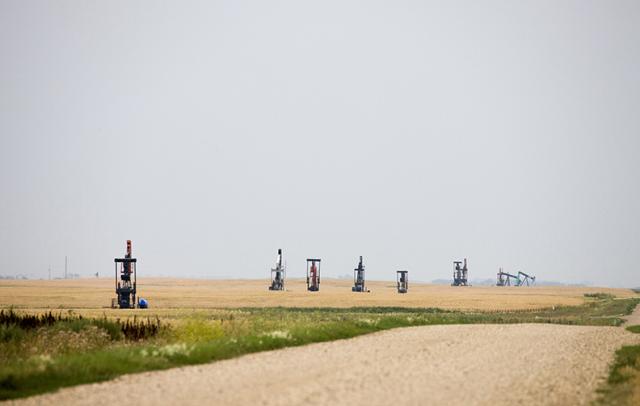
Move over, Permian Basin, Saskatchewan thermal oil is vying for the crown for low-cost North American production. Not only are breakeven costs very low, according to companies working in the heavy oil fields just east of Lloydminster—which straddles the border between the two provinces—but output can be sustained for 20 years, unlike shale wells.
The big player in the area is Husky Energy. Spokesperson Mel Duvall says the Saskatchewan thermal projects have some of the lowest costs in their portfolio, around $8/bbl. One of the ways Husky keeps costs low is to use a cookie cutter strategy to engineering the facilities: “We use a modular design approach. Essentially the four new plants are all built off the same design, which allows us to take these projects from sanction to first oil in about three years.”
Duvall says the company currently makes 80,000 bbl/d, while four new projects (Rush Lake 2 in early 2019; Dee Valley, Spruce Lake North and Spruce Lake Central in 2020) will boost production to 120,00l/d0b by 2021.
“We have a large portfolio of potential thermal develops both in Saskatchewan and Alberta that we are looking to bring forward over time,” he said in an email.
John Festival, , Black Pearl Resources, one of the other three producers active in the area, said smaller projects are built even quicker because of Saskatchewan’s streamlined review and approval process.
“In Saskatchewan, you make an application and they give you a rulebook that says, ‘This is what you must do to operate thermal projects in Saskatchewan,’” he said in an interview. “We just follow the rulebook and we go ahead and get our approvals quite quickly, whereas in Alberta the application process is extremely long, expensive, and painful, and it doesn't deliver a better project.”
Black Pearl thinks the Saskatchewan approach knocks down a thermal operation’s startup time from as high as five years in the Alberta oil sands to just a few months.
Festival agrees that costs in the province, until recently more known for wheat than oil, are very low. “The thermal operations we have at Onion Lake in Saskatchewan are, by far, our most economic, both from a growth standpoint and from a competitive standpoint,” he said. “It rivals some of the best production in North America. I think it’s better than the Permian.” Black Pearl is currently producing 6,000 bbl/d and expected to top out at 20,000 bbl/d.”
The Onion Lake field had experienced some primary production, mostly vertical wells, which got Black Pearl engineers thinking about a novel way to re-use them for SAGD (steam assisted gravity drainage) production. “We were the first to go back into a reservoir like that, drill horizontal wells for producers, and convert the vertical wells to steam injectors,” Festival said. “That was a first in Alberta and Saskatchewan, I think possibly the world because I've not seen another project that has done that. That was very innovative on our part.”
Husky is also innovating on its fields, using natural gas-powered steam generators with low nitrogen oxide burners. ”We are currently piloting three carbon capture technologies at our Pikes Peak South facility with the intention of rolling the successful technology out to our other operations, Duvall said. “Captured carbon can be injected into the ground, which helps increase our conventional oil production.”
The product is a heavy crude oil that Husky blends with condensate so it flows in pipelines. The company enjoys the benefits of vertical integration, shipping to the Lloydminster Upgrader and an asphalt refinery that supply markets in both Canada and the U.S. “We own a refinery in Lima, Ohio and have a project underway to increase its heavy oil processing capacity from 10,000 bbl/d to 40,000 bbl/d in 2019. We just acquired a refinery in Superior, Wisc., which also produces asphalt.”
While the big innovations are sexy, it is the smaller innovations that can really make a difference to production efficiency. Take inflow regulators, or “chokes,” the company uses to control the amount of steam injected into the reservoir, which enables operators to maximize efficiency. “We use these inflow control devices to improve performance,” Festival said. “We’ll also use double-walled, vacuum-insulated tubing so that we deliver steam right to the bottom of the reservoir. It costs a little more, but we've determined that the benefit justifies the cost.”
One innovation Black Pearl isn’t sold on just yet is lowering the steam-oil ratio by replacing steam with solvents, a technique increasingly used by most of the big Alberta oil sands producers. “We're not sure if it's cost-effective because you put expensive solvent in the ground and you need to recover maybe 70% to 80% at a minimum to make it economic,” according to Festival, who thinks the company will likely use natural gas as a cost-effective means of maintaining reservoir pressure.
Total Saskatchewan thermal oil production currently sits around 110,000 bbl/d, which includes the. Two smaller private producers, Serafina and Broadview, both make about 12,000 bbl/d each. With the Husky and Black Pearl expansions on the horizon, thermal oil in the province of one million will likely peak around 175,000bbl/d early in the 2020s, accounting for about 4% of Canadian oil supply.
Recommended Reading
For Sale, Again: Oily Northern Midland’s HighPeak Energy
2024-03-08 - The E&P is looking to hitch a ride on heated, renewed Permian Basin M&A.
E&P Highlights: Feb. 26, 2024
2024-02-26 - Here’s a roundup of the latest E&P headlines, including interest in some projects changing hands and new contract awards.
Gibson, SOGDC to Develop Oil, Gas Facilities at Industrial Park in Malaysia
2024-02-14 - Sabah Oil & Gas Development Corp. says its collaboration with Gibson Shipbrokers will unlock energy availability for domestic and international markets.
E&P Highlights: Feb. 16, 2024
2024-02-19 - From the mobile offshore production unit arriving at the Nong Yao Field offshore Thailand to approval for the Castorone vessel to resume operations, below is a compilation of the latest headlines in the E&P space.
TotalEnergies Acquires Eagle Ford Interest, Ups Texas NatGas Production
2024-04-08 - TotalEnergies’ 20% interest in the Eagle Ford’s Dorado Field will increase its natural gas production in Texas by 50 MMcf/d in 2024.






